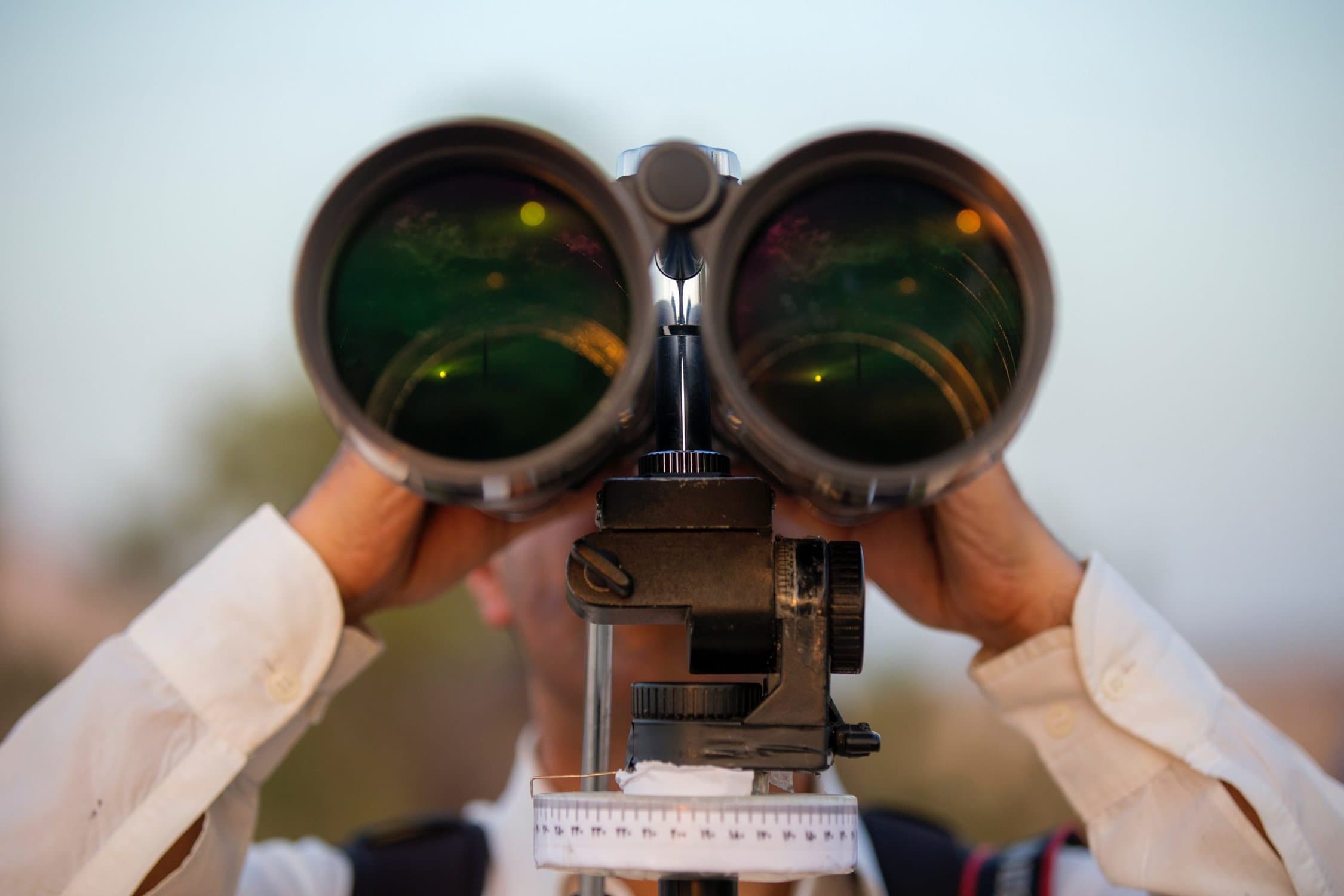Searching for your first set of birding binoculars? Ask any birdwatcher and they’ll tell you that when it comes to connecting with nature, binoculars are the perfect tool to help you get up close and personal without disturbing the birds.
But with all of the optical equipment on the market, it can be hard to decide which birdwatching binoculars to choose. In this article, we’ll go over some great choices for birdwatching binoculars as well as some helpful guidelines for choosing binoculars. Without further ado, let’s dive into the twelve best picks for birdwatching binoculars for beginners and pros alike!
We Recommend
Best Binoculars for Birding
1. Nikon Monarch M7 8X42 Nature Binocular
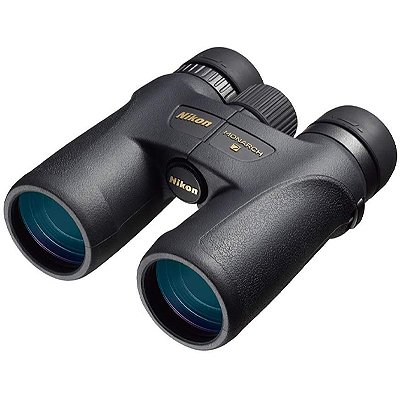
The Nikon Monarch M7 8X42 strikes an excellent balance between quality optics and affordability.
The Monarch M7 boasts clear and bright images due to dielectric multilayer prism coatings which allow for high light transmission. This makes the Monarch 7 a great choice for low light conditions.
With an impressively wide field of view (435 ft at 1000 yds), the Monarch M7 is a great piece of equipment for tracking birds in flight. A wide field of view allows you to follow a bird’s movements at a great distance without constant readjustment. For the birder with their eye on the sky tracking distant birds in flight, this is especially useful.
The M7s also present a fairly tight close focus, allowing for detailed viewings of nearby birds. For the feeder watcher or backyard bird photographer, this is a perfect balance between distance and detail.
On top of its build quality, Nikon offers a limited lifetime warranty. Overall the Nikon Monarch M7 performs exceptionally well at its price point, which is in the middle range for high-end optics.
What we liked
- One of the largest fields of view available (perfect for tracking birds in flight)
- Bright images even in low-light
- Razor-sharp images and outstanding contrast
- Waterproof & fog proof
- Sufficient eye relief for glasses wearers (long eye relief 17.1mm)
- Lightweight for a 42mm objective lens binocular
- No shakiness, easy to hold for longer period
What we didn’t like
- Sometimes Lens caps don’t stay on properly
- Questionable light chromatic aberration (unless you are an optics nerd, it’s not an issue)
Durability: Waterproof, Fogproof
Objective Lens Diameter: 42 mm
Magnification: 8x
Lens Coating: Dielectric High-Reflective Multilayer Coatings
Near Focus: 6.6 ft
Field of View: 435 ft @ 1,000 yds
Prism Type: Phase-Correction-Coated Roof Prism
Eye Relief: 17.1 mm
Weight: 1.4 lbs
2. Celestron Nature DX 8X42 Birding Binocular
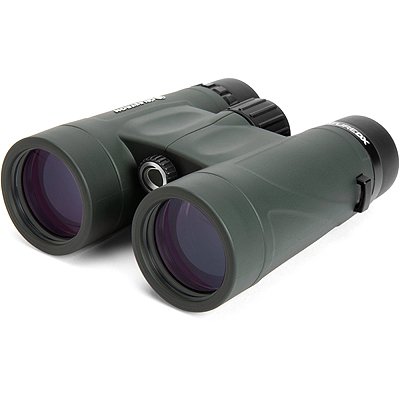
The Celestron Nature DX is a sturdy waterproof binocular that uses BaK-4 prisms. These prisms are well-known for their low-light applications and enhanced light transmission. Celestron is a trusted brand for birders and the Celestron Nature DX is an obvious choice for a low cost piece of equipment. For a new birder looking for a reliable first set of binoculars, the Celestron Nature DX might just be the way to go!
The BaK-4 roof prism configuration and fully multi-coated lenses promise excellent color accuracy. Fog-proof, waterproof, and easy to focus, the Celestron Nature DX is extremely user-friendly. For someone at the start of their journey into the optics hobby, these binoculars are a great choice. Lightweight, rugged, and easy to use, the Celestron Nature DX is a particularly strong choice for hiking or camping.
Of course, at a lower price the Celestron Nature DX is bound to have a few drawbacks. The build quality is simply not as high as some of the more expensive pieces of equipment on this list. The eye relief knob, for example, is a bit loose. At such a low cost, though, the Celestron Nature DX delivers a lot of bang for fewer bucks!
What we liked
- Best budget option for birders and wildlife enthusiasts
- Excellent clarity for the price
- Great for glasses wearers (long eye relief 18mm)
- Waterproofing allows you to use these binoculars in all weather conditions
- Great field of view that rivals mid-range and high-end 8x binoculars
- Lightweight and portable
What we didn’t like
- Not as comfortable to grip as some competitors
- Build quality is all around lower (though still quite good for the price)
- Slight chromatic aberration (unless you are an optics nerd, it’s not an issue)
Durability: Waterproof
Objective Lens Diameter: 42 mm
Magnification: 8x
Lens Coating: Fully Multi-Coated
Near Focus: 6.5 ft
Field of View: 388 ft @ 1,000 yds
Prism Type: Roof Prism Phase Coated Bak4
Eye Relief: 18 mm
Weight: 1.5 lbs
3. ZEISS Conquest HD 8X42 Binoculars
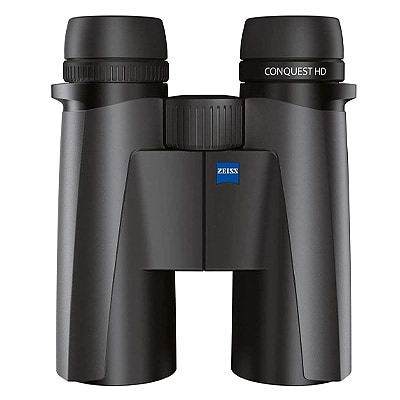
Another strong contender for birdwatching binoculars is the ZEISS Conquest HD. If the Celestron Nature is an ideal beginner choice, the enthusiast who is looking to take on some higher end equipment should consider the ZEISS Conquest instead.
These binoculars featured premium construction and were developed with optical perfection in mind. The ZEISS Conquest is one of the more expensive options featured on this list, but it does offer superior performance compared to many of its competitors. In optics, you do get what you pay for.
The binoculars come in a variety of models – with a minimum lens diameter of 32mm and a minimum magnification level of 8x. Unlike some other competitors at this level of magnification, the ZEISS Conquest does tend to run slightly heavy. We suggest considering the ZEISS shoulder harness, or any compatible shoulder harness, to take the weight off the neck during longer sessions.
The binoculars come with a five-year no-fault policy. If any issues arise with the binoculars during this time, the policy can be used for a replacement. The binoculars also come with a limited lifetime warranty. Read more about the ZEISS Conquest here.
What we liked
- Super sharp, bright, crisp images that help you see details of small birds
- Very good low-light performance
- Fast focus knob (quickly find and focus on a moving bird)
- Great for eyeglasses wearers
- Comfortable design with a sure grip (you will not drop them)
What we didn’t like
- The warranty has some limitations
- Premium price tag (but worth it)
- Lens covers could be better (a common issue with all brands)
- Slightly heavy
Durability: Moisture resistant
Objective Lens Diameter: 32mm
Magnification: 8x
Lens Coating: T Premium
Near Focus: 6.6 ft
Field of View: 384 ft @ 1,000 yds
Prism Type: Schmidt-Pechan
Eye Relief: n/a
Weight: varies
4. Vortex Optics Diamondback HD Binoculars
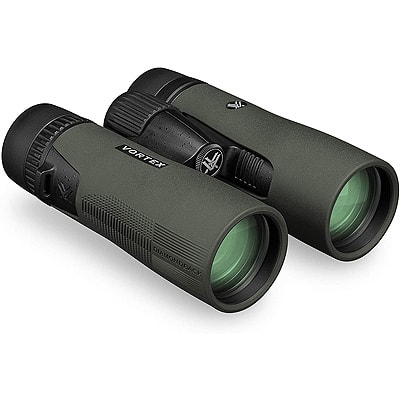
The Vortex Diamondback 8×32 is perhaps the best choice on the list for short range activities. With an impressive close focus of just five feet, this set of binoculars is the best friend of a birder who wants to get a close zoom on a nearby subject. Backyard birders with window feeders will especially enjoy this piece of equipment. The Vortex Diamondback uses fully multi-coated optics to ensure color output and contrast ratio for crystal clear views.
The aforementioned close focus of 5 feet means that nearby images are brought into sharp focus easily. On top of that, the Vortex Diamondback is rugged and portable for the birder on the go.
Best of all, the Vortex Diamondback won’t break the budget. Sure, this is not the most state of the art piece of equipment on this list, however, for a reliable piece of equipment that is easy to use and delivers high resolution images at close ranges, the Vortex Diamondback does not disappoint.
To sweeten the pot, so to speak, the Vortex Diamondback 8X32 comes with a rain guard and full waterproof covering to protect your purchase from the elements as you explore nature up close!
What we liked
- Adjustable eyecups
- Can be used with eyeglasses
- Diopter adjustment
- Rubber armor
- O-ring seal
- Fogproof construction
- Multi-coated lenses
What we didn’t like
- Lower build quality than some of the more expensive options, but excellent for the price.
Durability: Waterproof, fog proof, rubber armor
Objective Lens Diameter: 42mm
Magnification: 8x
Lens Coating: Multi-coating
Near Focus: 5.0’
Field of View: 393’ / 7.5 degrees
Prism Type: n/a
Eye Relief: 17
Weight: 21.8 oz
5. ZEISS 8X25 Terra ED Compact Pocket Binocular
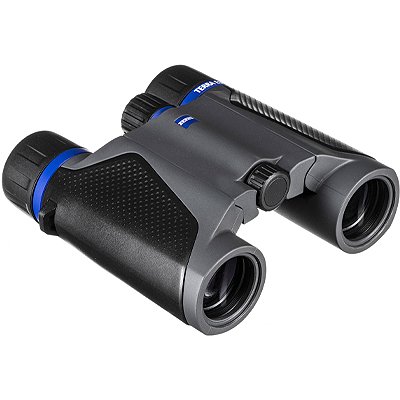
If you’re looking for a lightweight binocular, the ZEISS Compact Binocular might just be for you! These binoculars only weigh .68lbs and have an extremely compact folding design.
With the 8x magnification, you can still get close to the action and the field of view on this itsy bitsy piece of equipment is surprisingly large. These binoculars are great for travelers looking to minimize storage space without reducing quality. For birders who make long treks to finally spot that elusive life-lister, the ZEISS Terra ED Compact binocular is perfectly portable and ready to go!
The ZEISS 8X25 Terra ED Compact Pocket Binocular, though small, feels great in the hands and the focus knob turns effortlessly. These binoculars don’t feel too delicate or tedious, like one might expect for a piece of equipment so small.
Anyone interested in these binoculars will also be happy to know that the lenses are coated in ZEISS’ trademark Hydrophobic ZEISS MC to optimize image clarity. Read more about the ZEISS 8X25 Terra ED Compact Pocket Binocular here.
What we liked
- Only weighs .68 lbs
- Impressive field of view considering its size
- Waterproof
- Hydrophopic Zeiss MC lens coating
- Great field of view
- Smooth focus knob
- Extremely clear views
What we didn’t like
- Low-light performance is less than ideal
- Smaller binoculars all around tend to suffer from lower clarity and precision
Durability: Weatherproof, Waterproof
Objective Lens Diameter: 25 mm
Magnification: 8x
Lens Coating: Hydrophobic ZEISS MC
Near focus: 6.2 ft
Field of view: 357 ft @ 1,000 yds
Prism type: Schmidt-Penchan Prism System
Eye Relief: 16mm
Weight: .68 lbs
6. Leica Trinovid 10X42 HD Bird Watching Binoculars
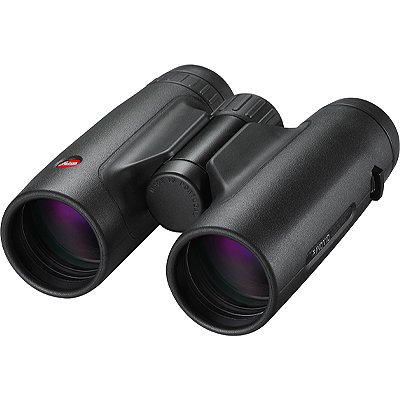
For those unfamiliar with the world of sports optics, the idea of spending upwards of 1,000 dollars on a single set of binoculars might sounds crazy. But when you compare the image quality and all around value of high-end binoculars with their more affordable competitors, it’s easier to understand why many enthusiasts enjoy the more expensive options.
It all comes down to choosing the best birding binoculars within your budget. If that budget happens to be fairly high, then you might want to consider these premium binoculars from Leica.
The Leica Trinovid is a fantastic choice for birding in low-light conditions. Thanks to a special HDC coating on all of its optics, this set delivers clear, sharp, and high contrast images from dawn until dusk. This coating enhances light transmission and ensures brighter and clearer images even in conditions that would present a real challenge for similar pieces of equipment.
The Leica Trinovid also boasts high durability and resistance to all sorts of damage. The Leica Trinovid is 100% waterproof, meaning it will survive submersion and resist water damage. This is a huge plus for most outdoor settings. The exterior features rubber armoring that provides a comfortable grip as well as impact resistance in case of an accidental drop. This is a good thing too, since the Leica Trinovid is one of the heavier pieces of equipment on this list.
The smaller exit pupillary distance of the Leica Trinovid contributes to the sharpness of its images. Alongside this, 17 mm of eye relief makes this set serviceable for most glasses wearers, although some of the other sets on this list have longer relief.
The Leica Trinovid 10X42 HD Binocular offers a solid 10x magnification alongside an excellent field of view–355ft @ 1,000 yds.
That FOV rivals binoculars with an 8x magnification, so you’re getting the same FOV but at a higher magnification.
Leica binoculars come with a unique Adventure-Strap carrying system, which holds the binoculars securely to your body while hiking or hunting. This is another huge plus considering the heavier weight of this piece of equipment. Leica also includes a 10-year warranty on their binoculars. Read more about the Leica Trinovid here.
What we liked
- Sharp & vibrant images
- Waterproof & fogproof
- Great field of view at 10x
- Impressive close focus
- 10-year warranty
- Includes Leica Adventure-Strap
What we didn’t like
- The Adventure-Strap takes some getting used to
- Quite heavy
- High price tag (although this price is reflected in the product’s quality)
Durability: Waterproof, Fogproof
Objective Lens Diameter: 42 mm
Magnification: 10x
Lens Coating: Fully Multi-Coated
Near focus: 5.3 ft
Field of view: 355ft @ 1,000 yds
Prism type: Compact Bak4 Roof Prism
Eye Relief: 15.5 mm
Weight: 1.6 lbs
7. Vortex Optics 10X42 Viper HD Binocular
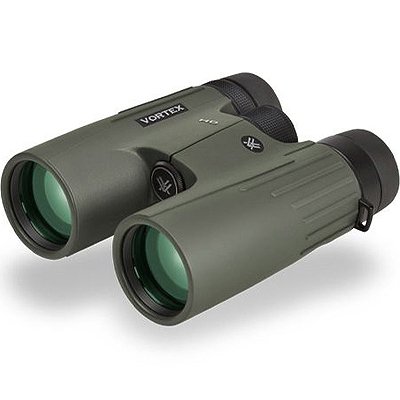
If you’re looking for a binocular that will last you a lifetime, then the Vortex Optics line has many great pieces of equipment on offer. One of their top sellers is the Vortex Optics 10X42 Viper HD Binocular.
These optics are an excellent mid-range binocular that features HD glass and an Unlimited Lifetime Warranty. These binoculars are quite compact considering their magnification and also feature a very impressive close focus range. With just over 5 feet of close focus, the Vortex Optics Viper HD allows you to hone in on close subjects and enjoy the sharp magnification that this piece of equipment provides. The Viper is excellent for backyard birdwatching.
The 10X42 Viper HD’s durable design is both waterproof and fog proof, pair this with the Vortex brand’s unlimited warranty and you’ve got yourself a pair of binoculars that can tackle rugged conditions with no risk at all!
What we liked
- Excellent Unlimited Lifetime Warranty
- Quite light for a 10x magnification binocular
- HD glass for optimized image clarity
- Waterproof & fogproof
- Great close focus
Durability: Waterproof, Fogproof
Objective Lens Diameter: 42 mm
Magnification: 10x
Lens Coating: Anti-Reflective Coating
Near focus: 5.1 ft
Field of view: 319 ft @ 1,000 yds
Prism type: Roof Prism with Dielectric, Multi-Layer Coating
Eye Relief: 16.5 mm
Weight: 1.5 lbs
8. Celestron Trailseeker ED 10X42 Binoculars
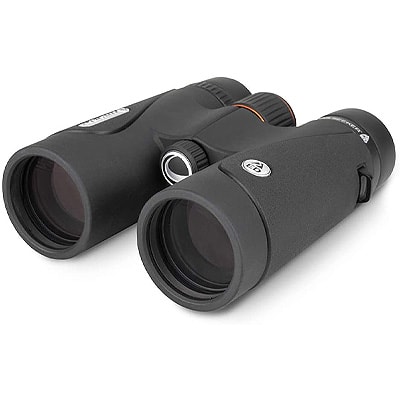
The Celestron Trailseeker ED 10X42 Binoculars come with a high magnification level that provides up to 10x zoom function. Like the previous Celestron entry, the Celestron TrailSeeker is an economical option for the birder, hunter, or outdoorsperson who does not want to sacrifice quality optics. Designed with image quality as a key focus, these binoculars feature BaK-4 prisms. BaK-4 prisms are well-known for their image sharpness.
These prisms have been phase and dielectric coated, which means that these mid-sized binoculars provide state of the art best light transmission. All the colors are rendered with accuracy, and there is little to no optical loss. You can easily identify small, quick-moving songbirds using these binoculars in dense brush at dusk.
With a wide field of vision, the Celestron TrailSeeker is ideal for following targets at a long distance without constant readjustments. The body of the Celestron TrailSeeker is incredibly rugged and durable.
The eyecups can be adjusted and feature built-in padding. The padding provides extra eye relief. A carrying case is included with the purchase of these binoculars.
What we liked
- Industrial design
- Armored body
- Waterproof chassis
- Adjustable eyecups
- BaK-4 prism system
- True-to-life colors
- ED lens elements
What we didn’t like
- Tripod adapter costs extra
Durability: Waterproof
Objective Lens Diameter: 42mm
Magnification: 10x
Lens Coating: ED
Near Focus: n/a
Field of View: n/a
Prism Type: BaK-4
Eye Relief: n/a
Weight: 1.47 lbs
9. Vortex Optics Razor HD Roof Prism Binoculars
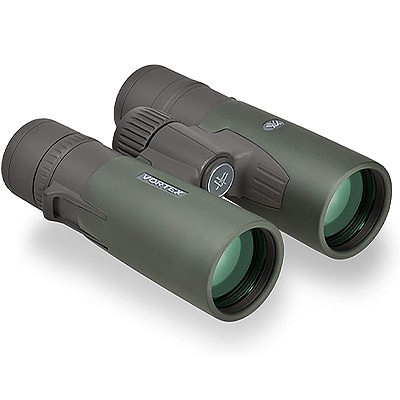
The Vortex Razor HD is yet another entry which falls under the high-end category. For the birdwatcher or optics enthusiast with a higher budget, this piece of equipment is amongst the best on the market.
These binoculars come in a wide variety of sizes with varying levels of magnification. For most birdwatching activities, the best option is the 8x magnification Razor HD with 42 mm objective lenses.
The Razor HD system is extremely well constructed with a strong but relatively lightweight magnesium chassis and grippable rubber coating.
The lenses of the Vortex Razor are coated for scratch resistance as well as anti-glare. For image clarity, brightness, optical quality, durability, and ergonomics, the Vortex Razor is a fantastic all-arounder.
What we liked
- Rugged design
- Resistant to dirt, oil, and scratches
- Waterproof construction
- Multi-position eyecups
- HD viewing
- 8x magnification
- 42mm lenses
Durability: Waterproof
Objective Lens Diameter: 42mm
Magnification: 8x
Lens Coating: Razor HD coating
Near Focus: 6.0’
Field of View: 362’
Prism Type: n/a
Eye Relief: 16.5mm
Weight: 24.8 oz
10. Swarovski Optics 8.5X42 EL Binocular with FieldPro Package
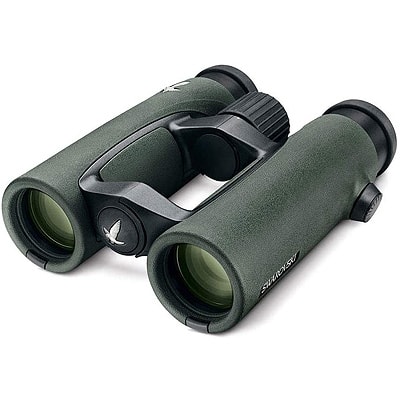
The Swarovski 8.5X42 EL Binoculars are another set of equipment that falls towards the high end of the price spectrum. Not to belabor the point, but these binoculars also demonstrate the wisdom of “you get what you pay for.”
The Swarovski 8.5X42 EL is a professional quality tool which delivers on every dollar of its price tag with sharp optical quality and durability that lasts. There are several models available for this line with magnification ranging from 8x to 12x. The smaller 8X32 model is a great choice for portability.
The biggest model features 12x magnification and a 50mm lens diameter. The binoculars offer 20mm eye relief to help improve eye comfort. This is important during long viewing sessions and makes this set ideal for birdwatchers who wear glasses.
The Swarovski 8.5X42 EL and its alternative models come with a limited lifetime warranty.
What we liked
- Preferred by pros
- 42mm diameter
- 9mm exit pupil diameter
- 20mm exit pupil eye relief
- Comes with lift carrying strap
- Lifetime warranty
- 10-year warranty on body
What we didn’t like
- Lifetime warranty does not cover all parts
- Protective cover not included
Durability: Basic rugged design
Objective Lens Diameter: 42mm
Magnification: 8x
Lens Coating: Multi-coating
Near Focus: n/a
Field of View: 61 degrees
Prism Type: n/a
Eye Relief: 20mm
Weight: 29.5 ounces
11. Vanguard Endeavor ED II 8X42 Binocular
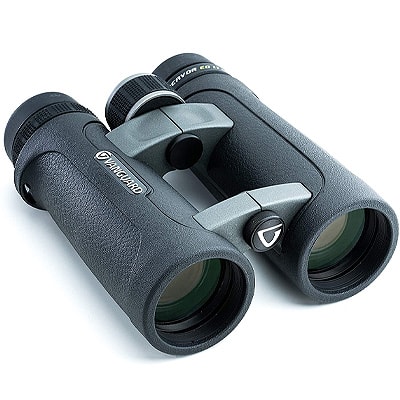
The Vanguard Endeavor ED II Binocular is a bargain for its price. With a price that falls in the low to mid range for optical equipment, the Vanguard Endeavor ED II packs a punch. Providing high light transmission and sturdy construction, this piece of equipment is reliable, durable, and user-friendly.
The binoculars use a Premium HOYA ED glass element. This helps to eliminate chromatic aberration and provide a true-to-life color experience.
Weighing in at around 1.7 pounds, the Vanguard ED II is on the slightly heavier side for binoculars of its size and construction. This gives this product a solid feel, but may contribute to fatigue. Birders on the go might want to outfit this particular piece of equipment with a strap or harness.
What we liked
- Rugged design
- 42mm objective lens diameter
- Built-in eye relief
- Open-bridge design
- Comfortable grip
- Enhanced light transmission
- Premium ED glass
What we didn’t like
- Open bridge design means a wider construction
Durability: Waterproof
Objective Lens Diameter: 42mm
Magnification: 8x
Lens Coating: Premium HOYA ED
Near Focus: 6.6 feet
Field of View: 7.2 degrees
Prism Type: Bak-4
Eye Relief: 19.5mm
Weight: 27.16 ounces
12. Athlon Optics Midas Roof Prism UHD Binoculars
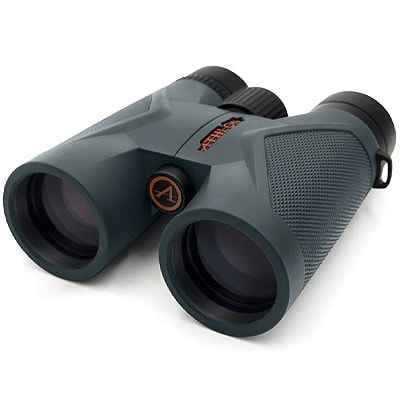
The Athlon Optics Midas Roof Prism UHD Binoculars come in two models. The default model features an 8×42 which provides a maximum magnification of 8x with a lens diameter of 42mm.
The binoculars offer an ESP Dielectric coating on its lenses. This protects against up to 99% of reflections, preventing glare and providing as sharp of an image as possible.
The Athlon Optics Midas uses roof prisms to deliver on light transmission and clarity. These binoculars shine in low light conditions and general outdoorsmanship.
With rugged construction and waterproofing, the Athlon Optics Midas is up to the challenge when it comes to wet and messy weather conditions.
What we liked
- UHD glass elements
- 42mm lens diameter
- Uses a roof prism
- Anti-reflective lens coating
- Accurate color reproduction
- 8.1-degree angle of view
- Long eye relief system
What we didn’t like
- Needs separate adapter to use a tripod
Durability: Waterproof
Objective Lens Diameter: 42mm
Magnification: 8x
Lens Coating: Anti-reflective
Near Focus: 6.5 ft
Field of View: 8.1 degree
Prism Type: n/a
Eye Relief: 17.2
Weight: 1.56 lbs
What Magnification Do You Need for Birding?
The best magnification for birding is between 7x-10x. A binocular’s magnification is indicated as the first number detailed on a pair of binoculars such as 8×42. The first number indicates the magnification, or how much larger an object will appear in the lens. The second number refers to objective lens diameter, which helps collect light to project vibrant images.
The most popular binocular specs for birding are 8×42 or sometimes 8×32. However, birdwatchers who want a bit more magnification tend to prefer 10×42. The reason these specifications are so popular is because both 8x and 10x binoculars provide the perfect balance of magnification, clarity, and field of view. These specifications combined help birdwatchers locate and identify birds more quickly and accurately. Larger binoculars tend to be shaky and may need a tripod to produce a stable image.
If you are new to birding or perhaps just looking for a pair of binoculars to view birds at your feeder, quality 8×42 binoculars are the best option. If you are a more experienced bird watcher, or someone with a need to identify birds at a more significant distance, then a 10×42 binocular will enhance the projected image more, making identification a bit easier.
Related: 5 Best Birding Scopes 2020 (+Beginners Guide)
How much do binoculars cost?
Binoculars are highly specialized pieces of optics equipment. The differences between each model may seem minimal to most, but to optics aficionados the difference between a cheap piece of equipment and professional optics are obvious.
Under $100
It is possible to find a serviceable pair of binoculars under $100, but there are a lot of cheap models out there that aren’t worth your time or money. If you do land a decent set of binoculars under $100, be very careful not to drop them.
The build quality at this price point tends to be a major concern and any shock can easily cause a misalignment that renders binoculars useless. At lower price points, binoculars are also prone to glare, fogging, scratching, poor light transmission, and color issues. When choosing a pair at this price point, do your research and stick to trusted brands.
Optics at this price point may not be able to deliver crystal clarity or a bulletproof build, but for the casual birder there are plenty of under $100 dollar gems if you do your research.
$100-$300
This price range is an excellent budget for beginner birdwatchers to get started in the world of birding. Binoculars in this range will be weatherproof and images will be clear enough to identify birds easily.
There is a world of difference between a $100 dollar set and a $300 dollar set, but for a beginner this price range will definitely get the job done. Binoculars in this price range may still experience some of the issues that tend to come with cheaper equipment. It is likely that they may underperform in low light. Build quality may also suffer. You may find that the included strap is cheap and eye-cups may be quick to fall off after a period of use. Again, research is key!
$300-$500
The next step-up will include binoculars that are waterproof and fog proof. Warranties will be better in this price range. Image quality will also improve. Images will be brighter and sharper due to better glass and higher quality prisms. This price range is great for birders looking for mid-range optics.
$500-$1000
Binoculars over $500 will perform very well. Images will be incredibly sharp, colors vibrant, even the focus knob will roll smoothly. The binoculars in this range will also be waterproof, fog proof, and sometimes dust- and shockproof. Overall build quality will be excellent, but the image quality is the true defining characteristic here. Most manufacturers will provide comprehensive warranties at this price point which demonstrates the faith they have in their products.
What about people with glasses?
If you are a glasses wearer don’t despair! You can use binoculars with glasses. Binoculars are made to accommodate all kinds of people, even those who wear glasses. People who wear glasses should look for equipment with a longer eye relief, as this allows the user to see images clearly without removing their glasses.
Related: 12 Binoculars for People With Glasses
Adjusting the diopter
So you’ve bought your first set of binoculars, now what? The first thing everyone should do when trying out a new pair of binoculars is to learn to correctly focus them. Start by learning to adjust the diopter accurately. To do this, follow these simple steps:
- Set the diopter adjustment to zero.
- Cover the lens that has the diopter adjustment and use the central focus knob to focus the binoculars on a distant object. (You’ll only be using one lens and one eye during this step.)
- Uncover the lens that has the diopter adjustment and use the binoculars using both eyes.
- Adjust the diopter until the object comes into focus.
These steps help customize a binocular’s focus to fit an individual’s eyesight. Sometimes people may not even need their glasses if they can see clearly through binoculars after adjusting the diopter.
If you feel that you still need to use your glasses to enjoy your new binoculars, go ahead and use your binoculars while wearing your glasses, hopefully you’ve chosen a set with an accommodating eye relief. Be sure to adjust the diopter as needed.
Eye relief
One thing to be aware of is eye relief. Eye relief refers to the distance between the ocular lens and your eye that allows you to see the full field of view.
For people who wear glasses, it’s important to find a binocular that has an eye relief of at least 16 mm. This will give you enough room to comfortably look through your binoculars while also maintaining the optimal field of view.
How to choose birding binoculars?
When it comes to buying a pair of binoculars, there are a few features that are a must-have for birding. If you’re looking for binoculars specific to birdwatching, here’s what to look for.
Magnification
Magnification is no doubt the most critical aspect of a binocular. The magnification you want depends on what you want to do. For close-range use, such as hunting, birdwatching, and spectating, a magnification of up to 10x is suitable. For low intensity birdwatching outings, I tend to choose an 8x or 10x model. Note that higher magnification often results in a bit of shakiness. For the beginner on the go, an 8x would be ideal.
For uses that require a slightly longer range, up to 20x magnification may be appropriate. For longer-range use, such as when boating, target practicing, and traveling, consider anything from 20x up to 30x.
Objective lens diameter
The diameter of the objective lens is crucial as it decides how much light is being let in. This will, in turn, determine how clear the image is and how much information it carries.
Typically, the lens diameter should be between 30 and 50 mm. Larger objective lens sizes not only mean more information but also affect low-light performance. You’ll want large diameters if you’re into stargazing. For birders and explorers on the go, however, smaller lenses mean lighter equipment. For cases where portability matters, I tend to choose lenses between 32 mm and 42 mm.
Field of view
This is a very important spec that is often overlooked. The field of view refers to how much of an image comes into frame at a given distance. The field of view is often indicated as either a measurement (350 ft @ 1,000yds) or an angle (7.0°). A wide field of view is great because it allows for easy tracking when observing birds in motion.
Weather-proofing
Birding is a year-round activity. So no matter what season it is, you want to know that your binoculars can withstand the elements. Look for binoculars that are waterproof. Moisture inside the lens will ruin a pair of binoculars. Higher-end models may also feature fog proof, dustproof, and shockproof designs.
Close focus
Sometimes, if you’re lucky, a bird will appear much closer than you anticipated. A binocular with a good close focus will allow you to view objects that are nearby. Look for a binocular that can focus on objects within 5-8 ft. If you intend to do more close range birdwatching, such as feeder watching, 5-6 ft will likely suit your needs the best.
Related: 5 Best Binocular Harnesses in 2022 (Low-Profile & Full-Size)
Frequently asked questions
What is the best magnification for binoculars for bird watching?
The best magnification for birdwatching depends a lot on the birdwatcher’s needs. Generally, I would suggest 8x for beginners, but some birders enjoy the strong magnification of 10x or even 12x binoculars.
What are the best binoculars for birding?
The best all around binoculars for birding from the options that we reviewed are the Vortex Optics Diamondback HD Binoculars because they provide crystal clear viewing with vibrant and accurate colors, all while balancing their price tag.
Are 10×42 binoculars good for bird watching?
A 10x maximum magnification combined with a 42mm set of lenses can provide excellent performance when viewing birds. Beginners may find such equipment shaky and heavy, but with a bit of practice anyone can get the hang of using equipment at this size.
Which is better 8×42 or 10×42 binoculars?
Neither 8×42 nor 10×42 are better for birdwatching. Both sizes provide unique strengths which may suit the needs of different birders under different circumstances. For usability, I prefer 8x42s, but 10x42s are obviously more powerful.
Are 10×50 binoculars good for birding?
A 10×50 set of binoculars will allow you to get a better view of birds, even at a further distance, the larger size of such binoculars may make them a bit unwieldy.
What are the best lightweight binoculars for bird watching?
The best lightweight binoculars for bird watching are the ZEISS 8X25 Terra ED Compact Pocket Binoculars. I chose them for this slot because they are both lightweight and generally very compact and portable.
How much does a good pair of binoculars cost?
Pricing differs a lot between binoculars. For a total beginner, it is entirely possible to find a pair that fills one’s needs for under $100, but as you learn more about optics, you may notice the drawbacks of such a cheap piece of equipment. A decent pair is likely to cost over $200. There are some that can cost more than $1,000 but this price point usually accompanies more professional binoculars.
What are the best Swarovski binoculars for birding?
The Swarovski 10×42 EL Binoculars offers great eye relief, an extra durable construction, and high-quality HD viewing lens elements. Swarovski is a fantastic brand and the Swarovski 10×42 EL Binoculars are a strong example of this brand’s quality.

